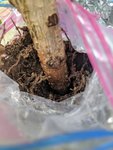Mikecheck123
Omono
The top of this gingko is obviously not happy. Is there anything I can do (or should have done)?

Under the covers, I see nubs of roots starting, but not much else.

Thanks for any pointers.
More info:
I actually started this as a @sorce radialayer, but encountered at least three problems with it. My bonsai mix in the container was staying too dry. The moss also didn't seem secure enough against the trunk. And worst of all, the container had become a literal hotel for earwigs, who like to eat any new growth they can find.
So I started over with the traditional approach, making a new cut just above the old one. I'm sure that didn't help.

Under the covers, I see nubs of roots starting, but not much else.

Thanks for any pointers.
More info:
I actually started this as a @sorce radialayer, but encountered at least three problems with it. My bonsai mix in the container was staying too dry. The moss also didn't seem secure enough against the trunk. And worst of all, the container had become a literal hotel for earwigs, who like to eat any new growth they can find.
So I started over with the traditional approach, making a new cut just above the old one. I'm sure that didn't help.
